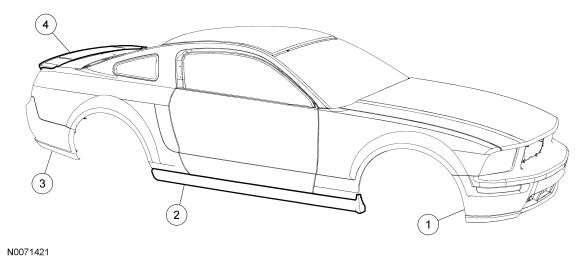SECTION 501-35: Body Repairs
| 2014 Mustang Workshop Manual
|
DESCRIPTION AND OPERATION
| Procedure revision date: 01/07/2013
|
NOTE: The following illustration(s) are not all-inclusive of trim levels available. The actual trim level of the vehicle will determine the viability of carrying out a plastic repair.

| Item | Part Number | Description |
|---|---|---|
| 1 | 17D957 | Bumper cover (front) — Thermoplastic Olefin (TPO) |
| 2 | 10155 LH/ 10154 RH | Rocker panel moulding — TPO |
| 3 | 17K835 | Bumper cover (rear) — TPO |
| 4 | 41602 | Decklid spoiler — Acrylonitrile Butadiene Styrene (ABS) |
Several considerations will determine viability of plastic repair procedure(s):
Several types of plastic are in use for automotive application. However, all plastics will fall into 2 primary categories of thermoplastic or thermosetting plastic.
Generally, thermosetting plastics are made with 2-part thermosetting resins. When mixed together, heat is generated, producing a cure that is irreversible. Because of this, thermosetting plastics will require the use of a 2-part adhesive for repair.
Sheet-Molded Composite (SMC) is a type of thermosetting plastic that uses glass fibers or nylon fibers in combination with thermosetting polyester resins. When fully cured SMC is strong and rigid.
SMC is similar, but not identical, to fiberglass. Ford Motor Company uses SMC in components such as fenders, hoods and liftgates.
Thermoplastic compounds are manufactured by a process that is reversible. Thermoplastics can be remolded repeatedly by reheating. This characteristic of thermoplastics makes plastic welding a possible repair alternative. A repair of thermoplastic compounds is still possible through the use of 2-part adhesive and filler repair materials and reinforcements as needed. Thermoplastics are widely used in interior trim components, wheel flares, body side cladding and bumper covers.
Polyolefins fall into the family of thermoplastics with one unique characteristic: an oily or waxy feel to the material when sanded or ground. Polyolefin lends itself very well to remolding through the use of heat. Because of this, components made of this material lend themselves well to the possibility of plastic welding. Most adhesive repair materials and paint will not bond to the surface of a polyolefin unless an adhesion promoter specially formulated for plastic is first applied to the exposed raw surface. Otherwise, polyolefins are repaired like most other thermoplastics. Some typical uses of polyolefins are bumper covers, fan shrouds and wheel housings.
Correct identification of the various types of plastic is necessary to select the appropriate repair method(s) to carry out high quality plastic repairs. Refer to Plastics Identification in this section.